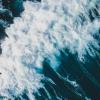The main purpose of the hackathon was to explore the possibilities for multi use at sea or co-location at sea in the broadest sense. The challenge the participants were given was: “How we might design a viable and sustainable multi-use concept at sea that facilitates co-existence in the Nordic Ocean space?”
All together there were 13 selected participants from across the Nordics gathered to address the challenge. The hackathon was hosted by Iceland Ocean Cluster with support from the Centre for the Ocean and the Arctic. Justine Vanhalst, a biologist and project leader based in Reykjavik, facilitated the event.
What is multi use?
Co-location and cooperation between different industrial activities at sea, also known as multi-use, is a topic that is garnering growing interest in the Nordic countries and elsewhere. Multi-use could be a powerful tool to address some of today's greatest challenges, such as the climate and nature crisis, significant pressure on ocean areas. By co-locating activities, within a limited area, we can release areas for other uses, like marine conservation and fisheries. In addition, co-location can create positive synergies on several levels. It can help alleviate conflicting interests at sea, lower costs by sharing infrastructure and services, and increase the level of innovation and collaboration in value chains.
Visiting co-located businesses
Before the participants were divided into teams, they went on an excursion to multi-use facilities on land to see how they work in practice and get the inspiration flowing.
First stop was HS Orka’s resource park, is an unrivalled center for sustainable R&D, production and business. Developed around HS Orka's historical power plants the Resource Park offers multiple streams from the geothermal resource and is splendid example of circular economy.
Next stop was Aurora Abalone to get insights into farming of abalone shellfish and seaweed production in sea cage aquaculture and using the same source of geothermal energy as the Blue Lagoon spa resort. They also learned more about the Nordic Innovation-funded project CircleFeed, in which Aurora Abalone is a partner.
Third stop was Matorka for a guided tour around a land-based a sustainable Arctic charr farm. It is located within the HS Orka resource park, the farm has a unique water re-use system that allows them to be more water and energy efficient.
Last stop was the Iceland Eco-Business Park. It is a newly established co-location project of the Iceland Ocean Cluster that was formerly destined to be an aluminum smelter but the site is instead being transformed into a circular economy and resource sharing hub for green and blue industries, entrepreneurs and research following an industrial symbiosis model.
Building concepts and prototypes
After returning the participants were divided into teams with the purpose to discuss, draft, and develop virtual representations of marine industrial parks or similar installations that place different sea-based activities in the same place, at the same time.
The teams worked throughout the day, and it became clear that everyone chose to look at ways to re-purpose existing oil and gas platforms – an important question for the Nordic region, with many rigs slated to be decommissioned in the near future.

The pitch
On Friday afternoon, the teams pitched their concepts to a judging panel consisting of Heiða Kristín Helgadóttir (Iceland Ocean Cluster), Anne Katrine Normann (UiT - Centre for the Ocean and the Arctic), Bala Kamallakharan (Iceland Venture Studio), Paula Gould (Float and gather ehf.) and Maryke Musson (Matorka).
Ultimately the judging panel selected team Blue Wast Renewable Aquaculture as the winners. Their concept was based on a food energy nexus working together with traditional oil and gas companies utilizing old oil rigs. The winning team consisted of Leidy Lagos (AKVA group), Thomas H. Lambaa Giehm (Aqua-Spark), and Vahid Abbasi (University of Borås).
See the pitches from all the teams:

Words from the winning team
When asked about what the hardest part of the problem was to solve Vahid Abbasi is clear. "I think the hardest parts was the connection between the existing facilities in the Nordic seas with the ideas that we had. How do we connect them and how do we consider the circularity of economic parts? Sustainability as a whole was also important. Also the environment perspective was very important for us and also the economy in it."
On what impact their solution could have for the Nordic, Thomas H. Lambaa Giehm elaborates; "Well, I think because our solution is based on a food energy nexus and working together with traditional oil and gas companies utilizing old oil rigs in the North Sea. There are hundreds of oil rigs in the North Sea and it looks like they will have to be decommissioned in the next 15 to 20 years, which is going to cost more than 50 billion. Our solution is a way for the oil companies to reduce that cost by converting their infrastructure to another use while at the same time society benefits because we get to use healthier, more healthy food while also utilizing waste streams to produce more energy at the same time."
On the question if the Nordic perspective made it harder or easier to solve the task, Leidy Lagos answeres: "I think it was easier because we are from different countries in the Nordic area, so then it takes the best of each of the countries. So I think it was some nice synergy.
Final thoughts
There were many great ideas and a wide variety of concepts. The teams had the luxury of only their imagination setting the limits. In the real world, of course, economics and the business case will play a central role for these concepts to work. The overarching goal of the hackathon was to trigger creativity, see what might be possible, and build on good ideas that could form the basis for a main challenge call.





